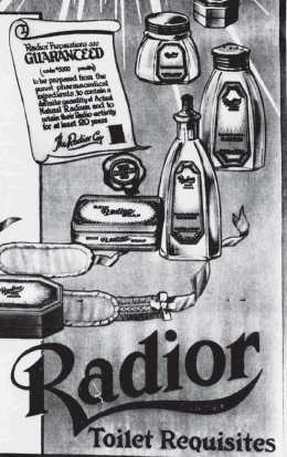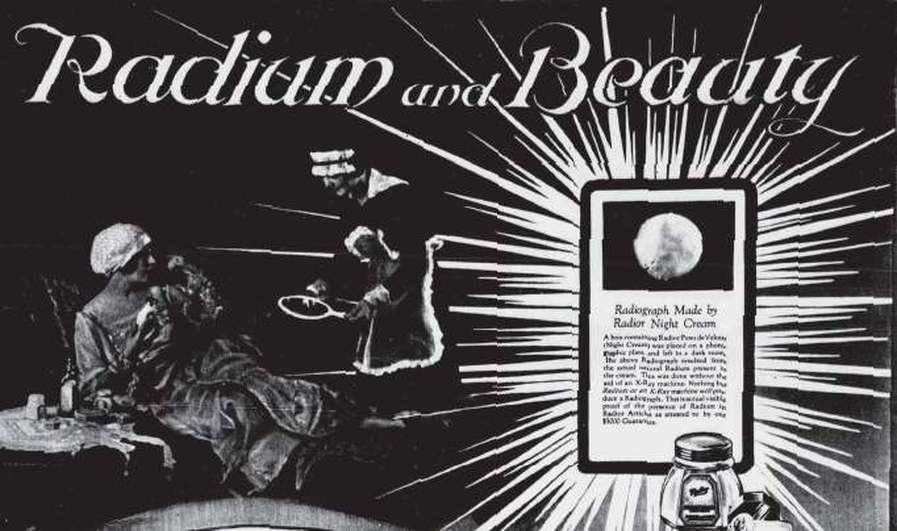Radium!
|
Wouldn’t you have liked this “Thursday Special” advertised back in 1910?
We have seen in "Sell It To Me!" how various merchants used Carnival Glass as a special offer / inducement to encourage customers to visit their store. However, by any standards, this offer was indeed special! Just 8 cents for what was probably a piece of Millersburg Carnival Glass that had been transported across the entire USA to Tacoma on the west coast. That was quite a deal! |
The choice of name - Radium - was an interesting decision by the Millersburg management, no doubt appealing to the popularity and interest in Marie Curie’s famous 1902 discovery. The patterns shown in the Radium Glass ads are: centre, Rays and Ribbons. The small comport above it, is most likely Leaf and Little Flowers. The four bowls around the centre are Grape Wreath (top left), Grape Wreath Variant (top right and bottom left) and Blackberry Wreath (bottom right).
|
Millersburg certainly pushed the "Radium Glass" sales pitch very hard, as these contemporary adverts from 1910-1911 show. In a very clever marketing ploy, Millersburg used the descriptive term Radium for their Carnival Glass in two very different ways. Firstly, to describe glass that contained uranium as a colourant (Vaseline Carnival Glass), and secondly, to refer to their "signature" shiny, multi-coloured and mirror-like iridescence on regular Carnival Glass that did not contain uranium. |
On the left is a Millersburgh Holly Sprig bowl in marigold with their renowned radium irridescence - it is not Vaseline.
Centre is a Vaseline Fleur de Lys footed bowl (courtesy of Seeck Auctions), and on the right is the only known Feather and Heart pitcher in Vaseline.
Centre is a Vaseline Fleur de Lys footed bowl (courtesy of Seeck Auctions), and on the right is the only known Feather and Heart pitcher in Vaseline.
Trouble ahead
The reality for Millersburg, however, was not as positive as their sales pitch suggested. The factory was relatively short-lived, as we explain in our major feature, Millersburg - the Rise and Fall. The 1911 ad, above right, provided a hint: at that time, the factory was already under some pressure to meet its bills, and there is a phrase in the ad which alludes to their need to generate some cash.
The ad said "Five and Ten Cent Specials". As we have explored in "Sell It To Me!", Carnival Glass makers used various outlets to sell their glass, one of which was the discount Five and Ten Cent Stores. It must have been very hard for John Fenton and Millersburg to be selling their glass this way - they prided themselves on superior design and high quality finish (which makes Millersburg's Carnival Glass so sought-after today), and so the need to convert their glass stocks into cash must have been overriding!
|
Radium was everywhere! Glass containing uranium as a colourant was available before Millersburg used the name "Radium". The “English Radium Glass” described in the ad (below left) was likely made in Stourbridge, England. Note that “iridescent colors” are mentioned in the ad. One might wonder if John Fenton had some of the iridescent “English Radium Glass” and was inspired to use the same name. In fact it was possible to find all sorts of items called Radium or similar names - the name played to a popular fascination with the scientific discovery of radium and radioactivity and the Nobel Prize in Physics that had been awarded to Marie and Pierre Curie in 1903. Here are several ads from the period showing how the properties of radium were popularly presented as beneficial - from boot polish to beauty products! If you wanted shiny shoes back in 1908 - “Radium” was the answer—certainly for the New Zealanders! But arguably the most troubling notion was that explained in the “Radior” ad for toilet requisites. Just look at the fancy warranty (on the right)! The cosmetics were guaranteed to “contain a definite quantity of Actual Natural Radium and to retain their Radio-activity for at least 20 years”. It’s hard to imagine today’s cosmetics companies using a similar idea, isn’t it? |











